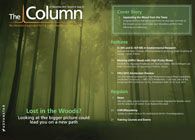Vitamin D detection
Scientists from Kingston University1, (London, UK) have developed and optimized an assay for the simultaneous detection of eight forms of vitamin D.
Scientists from Kingston University1, (London, UK) have developed and optimized an assay for the simultaneous detection of eight forms of vitamin D. Vitamin D is produced within the body on sunlight stimulation in the skin (photo-activated D3 analog) in addition to a supply from dietary sources (vitamin D2) making analysis complex.
There are a range of reports suggesting that a vitamin D deficiency may have links to a number of disorders from neurological disorders through to hypertension. Hypovitaminosis D, a condition describing a deficiency of vitamin D from either dietary or sunlight sources, is now widely recognized to be an affliction of the western world as a result of low sunlight exposure andpoor diet.
Lead author of the study Dr Iltaf Shah told The Column: “We observed that there was considerable debate about the veracity of vitamin D assays with many methods suffering from interferences from epimers, and in the case of mass spectrometric methods from isobars. Given that vitamin D deficiency is widespread and linked to a number of diseases, we set about developing a new assay with the capability of quantifying all eight forms of vitamin D. The assay uses two chromatographic columns used in tandem and mass spectrometer set to run three periods sequentially with optimized conditions for each analyte. Certified reference materials were also analysed to meet the standards outlined by National Institute of Standards and Technology (NIST).”
The investigators found that LC–MS–MS could be used to analyse serum samples under low‑light conditions; furthermore, the analysis of the multiple forms of the vitamin did not impact on the analysis of the commonly used 25OHD protein biomarker that is used in research and clinical applications.Shar went on to comment further: “The new method is sensitive, selective and accurate and it is efficient in extraction and chromatographic separation. The method is capable of accounting for the misleading measures due to the epimers and isobars. The results demonstrate the feasibility of applying the assay in research and clinical practice and to facilitate further in vivo investigation into the role of ubiquitous epimers.”
This new method holds promise for the improvement of current vitamin D analytical methods, and for the further development of in vivo research looking into the role of different vitamin D epimers.
1. I. Shah et al., Chemistry Central Journal, 6(112) (2012).
Regulatory Deadlines and Supply Chain Challenges Take Center Stage in Nitrosamine Discussion
April 10th 2025During an LCGC International peer exchange, Aloka Srinivasan, Mayank Bhanti, and Amber Burch discussed the regulatory deadlines and supply chain challenges that come with nitrosamine analysis.











